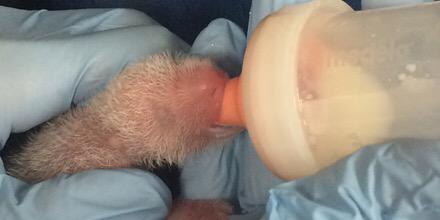Just days after giant panda Mei Xiang delighted everyone by delivering two cubs, the new mother is now coping with the loss of one of her twins.
The cubs were born on Aug. 22 at the Smithsonian’s National Zoo and have been rotated between their mother and the facility’s “panda team” ever since to give them the best shot at life. Mei Xiang was having trouble caring for both cubs, but wasn’t playing favourites, the zoo said. And, researchers have found that panda mothers are better at caring for one cub at a time, which is why they stepped in with bottle feeding and an incubator.
The smaller of the two unnamed cubs was with Mei Xiang from about 2 p.m. Aug. 25 until the morning of Aug. 26 when the panda team went in to swap the cubs.
“They assessed the little cub and had concerns because it had not increased in weight, appeared weaker and exhibited possible respiratory issues. The panda team immediately began taking actions to improve the condition of the smaller cub. They administered antibiotics, respiratory support, formula and fluids,” the zoo said in a statement.
The cub, just 79.8 grams in size, died that afternoon. A necropsy should help determine what killed the 4-day-old panda. But the mortality rate for panda cubs is high. About 26 per cent for males and 20 per cent for female in their first year in human care.
While twins happen in about 50 per cent of panda pregnancies, this was only the third time a giant panda in the United States had given birth to twins, according to the facility.
The panda team said it continues around-the-clock monitoring of Mei Xiang and the larger cub, which weighs 1377 grams. So far, the cub appears to be “strong and robust” and is behaving normally, and, well, urinating and defecating.
Still, the cub is considered vulnerable and at high risk.
Our giant panda cubs are doing well but we had a challenging night swapping cubs w Mei. Had to supplement feed 1 cub pic.twitter.com/XnOu5P9ABB
— National Zoo (@NationalZoo) August 24, 2015
Haven’t been able to swap cubs since 2p 8/24.Mei has larger cub.Smaller cub’s behaviors are good;still high-risk time pic.twitter.com/FrEG2lYfEz — National Zoo (@NationalZoo) August 25, 2015
We are sad to report that the smaller of the two panda cubs has died. We will continue to provide updates on social media w/ #Pandastory.
— National Zoo (@NationalZoo) August 26, 2015





